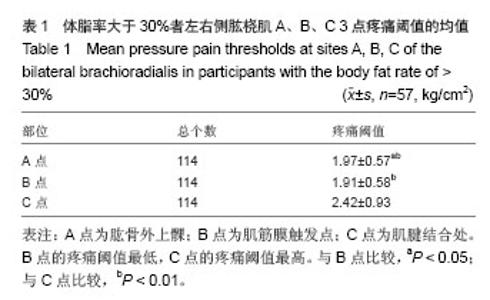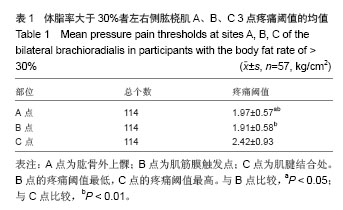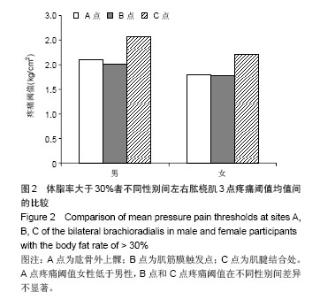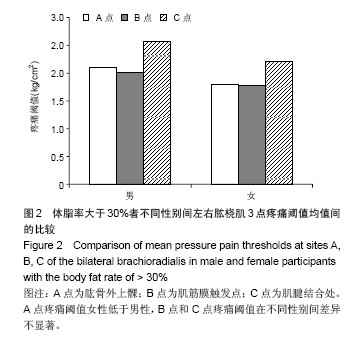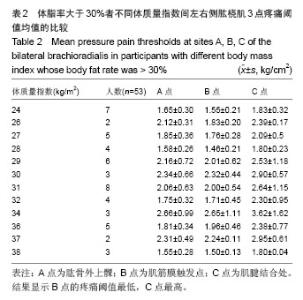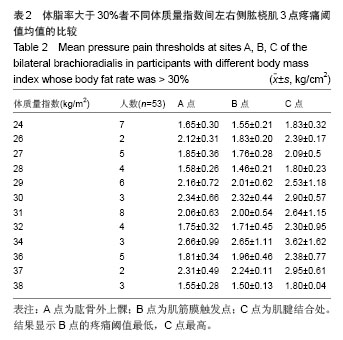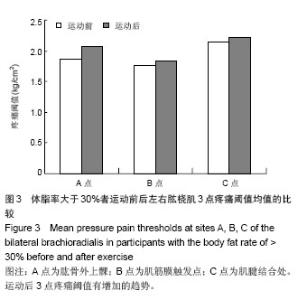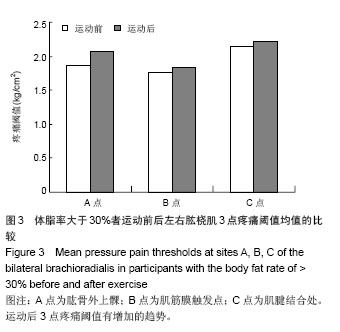Chinese Journal of Tissue Engineering Research ›› 2014, Vol. 18 ›› Issue (51): 8217-8222.doi: 10.3969/j.issn.2095-4344.2014.51.004
Previous Articles Next Articles
Skeletal muscle pain: the possible development of latent myofascial trigger points in the junction of brachioradialis muscle and tendon of obese people
Tang Li1, Huang Qiang-min2
- 1Tongren Hospital of Shanghai, Shanghai 200050, China; 2School of Human Movement Science, Shanghai University of Sport, Shanghai 200438, China
-
Online:2014-12-10Published:2014-12-10 -
Contact:Huang Qiang-min, M.D., Professor, Doctoral supervisor, School of Human Movement Science, Shanghai University of Sport, Shanghai 200438, China -
About author:Tang Li, Master, Rehabilitation therapist, Tongren Hospital of Shanghai, Shanghai 200050, China -
Supported by:a grant from Shanghai Key Laboratory of Development and Protection of Human Athletic Ability, No. 11DZ2261100
CLC Number:
Cite this article
Tang Li, Huang Qiang-min. Skeletal muscle pain: the possible development of latent myofascial trigger points in the junction of brachioradialis muscle and tendon of obese people[J]. Chinese Journal of Tissue Engineering Research, 2014, 18(51): 8217-8222.
share this article
| [1]Simons DG, Travell JG, Simons LS.Myofascial pain and dysfunction: the trigger point manual. Vol. 1, 2nd ed. Baltimore: Williams & Wilkins 1999. [2]Kao MJ, Han TI, Kuan TS,et al.Myofascial trigger points in early life. Arch Phys Med Rehabil.2007;88(2):251-254. [3]Fischer AA.New approaches in treatment of myofascial pain. Physical Medicine and Rehabilitation Clinics of North America.1997;8(1):153-169. [4]黄强民,敖丽娟,刘燕.肌筋膜触发点疼痛特征的要点分析[J].中国临床康复, 2004,8(23):4822-4824. [5]Hong CZ. Research on myofascial pain syndrome. Critical Reviews in Physical and Rehabilitation Medicine.2008;20(4):343-366. [6]Hong CZ. Muscle pain syndrome. In Braddom: Physical Medicine and Rehabilitation. Volume 43.4 edition. Elsevier, New York:2011:971-1001. [7]Hong CZ, Kuan TS, Chen JT, et al.Referred pain elicited by palpation and by needling of myofascial trigger points: A comparison. Archives of Physical Medicine and Rehabilitation. 1997;78(9):957-960. [8]Kuan TS, Hsieh YL, Chen SM,et al.The myofascial trigger point region: Correlation between the degree of irritability and the prevalence of endplate noise. American Journal of Physical Medicine and Rehabilitation.2007;86(3):183-189. [9]Fischer AA. Pressure threshold meter: Its use for quantification of tender spots. Archives of Physical Medicine and Rehabilitation.1986;67(11):836-838. [10]Ohrbach R, Gale EN.Pressure pain thresholds in normal muscles: reliability, measurement effects, and topographic differences. Pain.1989;37(3):257-263. [11]Ohrbach R,Gale EN.Pressure pain thresholds, clinical assessment, and differential diagnosis: reliability and validity in patients with myogenic pain. Pain.1989;39(2):157-169. [12]Reeves JL, Jaeger B, Graff-Radford SB.Reliability of the pressure algometer as a measure of myofascial trigger point sensitivity.Pain.1986;24(3):313-321. [13]Hong CZ.Algometry in evaluation of trigger points and referred pain.J Musculoskelet Pain.1998;6(1):47-59. [14]Hsieh YL, Kao MJ, Kuan TS,et al.Dry needling to a key myofascial trigger point may reduce the irritability of satellite MTrPs.Am J Phys Med Rehabil.2007, 86(5):397-403. [15]季成叶.儿童肥胖的遗传基因研究进展[J].中国学校卫生,2006, 27(2):93-94. [16]Bell LM, Byrne S, Thompson A, et al. Increasing body mass index z-score is continuously associated with complications of overweight in children,even in the healthy weight range. J Clin Endocrinol Metab.2007; 92:517-522. [17]Taylor ED, Theim KR, Mirch MC, et al. Orthopedic complications of over-weight in children and adolescents. Pediatrics.2006; 117:2167-2174. [18]黄强民.肌筋膜触发点疼痛或肌筋膜痛性综合症[J].颈腰痛, 2004,25(5):360-362. [19]Simons DG, Hong CZ, Simons LS. Endplate potentials are common to midfiber myofacial trigger points. Am J Phys Med Rehabil.2002;81:212-22. [20]Hubbard DR, Berkoff GM. Myofascial trigger points show spontaneous needle EMG activity. Spine.1993;18:1803-1807. [21]Sikdar S, Shah JP, Gebreab T, et al. Novel applications of ultrasound technology to visualize and characterize myofascial trigger points and surrounding soft tissue. Arch Phys Med Rehabil.2009;90:1829-1838. [22]Fischer AA.Pressure algometry over normal muscles. Standard values, validity and reproducibility of pressure threshold. Pain. 1987;30:115-126. [23]Lee KH, Lee MH, Kim HS, et al.Pressure pain thresholds[PPT]of head and neck muscles in a normal population.J Musculoskeletal Pain. 1994;2(4):67-81. [24]Jensen R, Rasmussen BK, Pedersen B, et al.Muscle tenderness and pressure pain thresholds in headache. A population study. Pain. 1993;52:193-199. [25]Jensen I,Nygren A, Gamberale F, et al.Coping with long-term musculoskeletal pain and its consequences: is gender a factor? Pain. 1994;57:167-172. [26]Fassbender HG,Wegner K: Morphologie and Pathogenese des Weichteilrheumatismus. Z Rheumaforsch 1973;32: 355-374., [27]Nishizawa S, Benkelfat C, Young SN, et al:Differences between males and females in rates of serotonin synthesis in human brain. Proc Natl Acad Sci USA 1997;94: 5308-5313. [28]Gunturu SD, Ten S. Complications of obesity in childhood. Pediatr Ann. 2007;36(2):96-101. [29]Bell LM, Byrne S, Thompson A, et al. Increasing body mass index z-score is continuously associated with complications of overweight in children, even in the healthy weight range. J Clin Endocrinol Metab.2007;92:517-522. [30]Stovitz SD, Pardee PE, Vazquez G, et al. Musculoskeletal pain in obese children and adolescents. Acta Paediatr.2008; 97:489-493. [31]de Sa Pinto AL, de Barros Holanda PM, Radu AS, et al. Musculoskeletal ?ndings in obese children. J Paediatr Child Health.2006;42:341-344. [32]Taylor ED, Theim KR, Mirch MC, et al. Orthopedic complications of overweight in children and adolescents. Pediatrics.2006;117:2167-2174. [33]Morrison SC, Durward BR, Watt GF,et al. Anthropometric foot structure of peripubescent children with excessive versus normal body mass: a cross-sectional study. J Am Podiatr Med Assoc.2007;97(5):366-370. [34]Villaroya MA, Esquivel JM, Tomás C,et al. Foot structure in overweight and obese children. Int J Pediatr Obes. 2007; 2(1):1-7. [35]Mickle KJ, Steele JR, Munro BJ. The feet of overweight and obese young children: are they l at or fat? Obesity (Silver Spring). 2006;14(11):1949-1953. [36]Dowling AM, Steele JR, Baur LA. What are the effects of obesity in children on plantar pressure distributions? Int J Obes. 2004;28(11):1514-1519. [37]Jiang L, Rong J, Wang Y,et al. The relationship between body mass index and hip osteoarthritis: a systematic review and metaanalysis. Joint Bone Spine 2011;78:150-155. [38]Felson DT, Zhang Y, Hannan MT, et al.Risk factors for incident radiographic knee osteoarthritis in the elderly: the Framingham study. Arthritis Rheum 1997;40:728-733. [39]Gadalla TM. Association of obesity with mood and anxiety disorders in the adult general population. Chron Dis Can.2009; 30:29-36. [40]Hudson JI, Pope Jr HG. The relationship between ?bromyalgia and major depressive disorder. Rheum Dis Clin North Am.1996;22:285-303. [41]Seshia SS. Chronic daily headache in children and adolescents. Curr Pain Headache Rep.2012;16:60-72. [42]Ursini F, Naty S, Grembiale RD. Fibromyalgia and obesity: the hidden link. Rheumatol Int 2011;31:1403-1408. [43]Clark EM, Ness A, Tobias JH. Social position affects bone mass in childhood through opposing actions on height and weight. J Bone Miner Res.2005;20:2082-2089. [44]Macfarlane GJ, Norrie G, Atherton K,et al. The in?uence osocioeconomic status on the reporting of regional and widespread musculoskeletal pain: results from the 1958 British Birth Cohort Study. Ann Rheum Dis.2009;68: 1591-1595. [45]Kawakita K, Itoh K, Okada K.Experimental Model of Trigger Points Using Eccentric Exercise. Journal of Musculoskeletal Pain 2008,16(1-2):29-35. [46]Xu YM, Ge HY, Arendt-Nielsen L. Sustained nociceptive mechanical stimulation of latent myofascial trigger point induces central sensitization in healthy subjects. J Pain.2010; 11(12):1348-1355. [47]Ge HY, Zhang Y, Boudreau S, et al. Induction of muscle cramps by nociceptive stimulation of latent myofascial trigger points. Exp Brain Res.2008;187(4):623-629. [48]Paul WH. Pain and motor control: From the laboratory to rehabilitation. J Electromyogr Kinesiol 2011;21(2):220-228. [49]Madeleine P. On functional motor adaptations: From the quanti?cation of motor strategies to the prevention of musculoskeletal disorders in the neck–shoulder region. Acta Physiol.2010;199:1-46. [50]Falla D, Lindstrøm R, Rechter L,et al. Effect of pain on the modulation in discharge rate of sternocleidomastoid motor units with force direction. Clin Neurophysiol. 2010;121(5): 744-753. [51]Hoyle JA, Marras WS, Sheedy JE,et al. Effects of postural and visual stressors on myofascial trigger point development and motor unit rotation during computer work. J Electromyogr Kinesiol.2011;21(1):41-48. [52]Gerdle B, Gronlund C,Karlsson S,et al.Altered neuromuscular control mechanisms of the trapezius muscle in ?bromyalgia. BMC Musculoskelet Disord 2010;11(1):42. [53]Chen SM, Chen JT, Kuan TS, et al.Decrease in pressure pain thresholds of latent myofascial trigger points in the middle finger extensors immediately after continuous piano practice. Journal of Musculoskeletal Pain.2000;8(3):83-92. [54]Han TI, Hong CZ, Kuo FC, et al.mechanical pain sensitivity of deep tissues in children-possible development of myofascial trigger points in children.BMC musculoskeletal disorders. 2012;13:13. |
| [1] | Li Dadi, Zhu Liang, Zheng Li, Zhao Fengchao. Correlation of total knee arthroplasty efficacy with satisfaction and personality characteristics [J]. Chinese Journal of Tissue Engineering Research, 2021, 25(9): 1346-1350. |
| [2] | Wei Wei, Li Jian, Huang Linhai, Lan Mindong, Lu Xianwei, Huang Shaodong. Factors affecting fall fear in the first movement of elderly patients after total knee or hip arthroplasty [J]. Chinese Journal of Tissue Engineering Research, 2021, 25(9): 1351-1355. |
| [3] | Lü Zhen, Bai Jinzhu. A prospective study on the application of staged lumbar motion chain rehabilitation based on McKenzie’s technique after lumbar percutaneous transforaminal endoscopic discectomy [J]. Chinese Journal of Tissue Engineering Research, 2021, 25(9): 1398-1403. |
| [4] | Huang Dengcheng, Wang Zhike, Cao Xuewei. Comparison of the short-term efficacy of extracorporeal shock wave therapy for middle-aged and elderly knee osteoarthritis: a meta-analysis [J]. Chinese Journal of Tissue Engineering Research, 2021, 25(9): 1471-1476. |
| [5] | Gao Yan, Zhao Licong, Zhao Hongzeng, Zhu Yuanyuan, Li Jie, Sang Deen. Alteration of low frequency fluctuation amplitude at brain-resting state in patients with chronic discogenic low back pain [J]. Chinese Journal of Tissue Engineering Research, 2021, 25(8): 1160-1165. |
| [6] | Zhao Zhongyi, Li Yongzhen, Chen Feng, Ji Aiyu. Comparison of total knee arthroplasty and unicompartmental knee arthroplasty in treatment of traumatic osteoarthritis [J]. Chinese Journal of Tissue Engineering Research, 2021, 25(6): 854-859. |
| [7] | Zhang Nianjun, Chen Ru. Analgesic effect of cocktail therapy combined with femoral nerve block on total knee arthroplasty [J]. Chinese Journal of Tissue Engineering Research, 2021, 25(6): 866-872. |
| [8] | Wu Gang, Chen Jianwen, Wang Shilong, Duan Xiaoran, Liu Haijun, Dong Jianfeng. Simple HyProCure subtalar stabilization in treatment of adolescent flexible flatfoot combined with painful accessory navicular bone [J]. Chinese Journal of Tissue Engineering Research, 2021, 25(6): 901-905. |
| [9] | Li Yan, Wang Pei, Deng Donghuan, Yan Wei, Li Lei, Jiang Hongjiang. Electroacupuncture for pain control after total knee arthroplasty: a meta-analysis [J]. Chinese Journal of Tissue Engineering Research, 2021, 25(6): 957-963. |
| [10] | Li Quanxi, Shen Yu, Wan Wei, Sun Shanzhi. Changes of abdominal wall mechanics and pain after tension-free inguinal hernia repair with polypropylene mesh [J]. Chinese Journal of Tissue Engineering Research, 2021, 25(4): 548-552. |
| [11] | Wang Xiaofei, Teng Xueren, Cong Linyan, Zhou Xu, Ma Zhenhua. Herbert screw internal fixation for treating adult osteochondritis dissecans of the knees [J]. Chinese Journal of Tissue Engineering Research, 2021, 25(3): 397-402. |
| [12] | Chen Ziyang, Pu Rui, Deng Shuang, Yuan Lingyan. Regulatory effect of exosomes on exercise-mediated insulin resistance diseases [J]. Chinese Journal of Tissue Engineering Research, 2021, 25(25): 4089-4094. |
| [13] | Yang Wei, Chen Zehua, Yi Zhiyong, Huang Xudong, Han Qingmin, Zhang Ronghua. Effectiveness of intra-articular injection of hyaluronic acid versus placebo in the treatment of early and mid-stage knee osteoarthritis: a Meta-analysis based on randomized, double-blind, controlled, clinical trials [J]. Chinese Journal of Tissue Engineering Research, 2021, 25(23): 3760-3766. |
| [14] | Liu Chang, Li Datong, Liu Yuan, Kong Lingbo, Guo Rui, Yang Lixue, Hao Dingjun, He Baorong. Poor efficacy after vertebral augmentation surgery of acute symptomatic thoracolumbar osteoporotic compression fracture: relationship with bone cement, bone mineral density, and adjacent fractures [J]. Chinese Journal of Tissue Engineering Research, 2021, 25(22): 3510-3516. |
| [15] | Jiang Hai, Yu Yu, Liu Zhicheng, Zhang Qiliang. Treatment of plantar fasciitis with extracorporeal shock wave and corticosteroid injection: comparison of plantar pressure and gait [J]. Chinese Journal of Tissue Engineering Research, 2021, 25(21): 3286-3291. |
| Viewed | ||||||
|
Full text |
|
|||||
|
Abstract |
|
|||||
